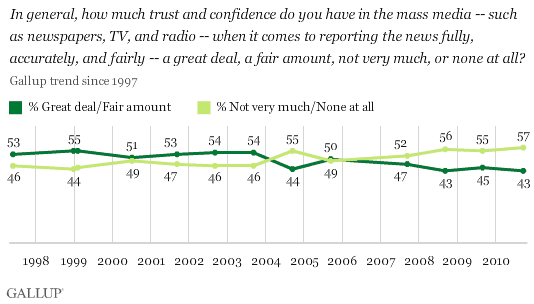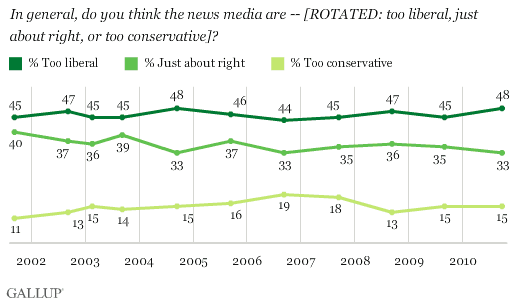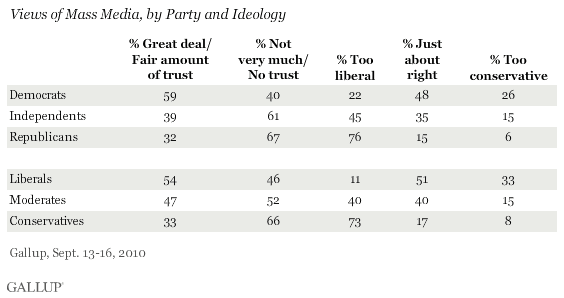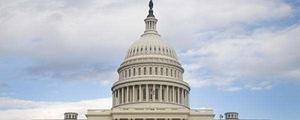WASHINGTON, D.C. -- For the fourth straight year, the majority of Americans say they have little or no trust in the mass media to report the news fully, accurately, and fairly. The 57% who now say this is a record high by one percentage point.

The 43% of Americans who, in Gallup's annual Governance poll, conducted Sept. 13-16, 2010, express a great deal or fair amount of trust ties the record low, and is far worse than three prior Gallup readings on this measure from the 1970s.
Trust in the media is now slightly higher than the record-low trust in the legislative branch but lower than trust in the executive and judicial branches of government, even though trust in all three branches is down sharply this year. These findings also further confirm a separate Gallup poll that found little confidence in newspapers and television specifically.
Nearly half of Americans (48%) say the media are too liberal, tying the high end of the narrow 44% to 48% range recorded over the past decade. One-third say the media are just about right while 15% say they are too conservative. Overall, perceptions of bias have remained quite steady over this tumultuous period of change for the media, marked by the growth of cable and Internet news sources. Americans' views now are in fact identical to those in 2004, despite the many changes in the industry since then.

Democrats and liberals remain far more likely than other political and ideological groups to trust the media and to perceive no bias.

Lower-income Americans and those with less education are generally more likely to trust the media than are those with higher incomes and more education. A subgroup analysis of these data suggests that three demographic groups key to advertisers -- adults aged 18 to 29, Americans making at least $75,000 per year, and college graduates -- lost more trust in the media in the past year than other groups, but the sample sizes in this survey are too small to say so definitively.
Bottom Line
Gallup's annual update on trust in the mass media finds Americans' views entrenched -- with a record-high 57% expressing little to no trust in the media to report the news fully, accurately, and fairly, and 63% perceiving bias in one direction or the other. At the same time, the steady nature of these views stands in contrast to Americans' views of the three branches of government, which are all down sharply this year. Thus, in an environment in which few institutions elicit high levels of trust, it appears the media are neither gaining nor losing significant ground -- but are just managing to hold steady.
Survey Methods
Results for this Gallup poll are based on telephone interviews conducted Sept. 13-16, 2010, with a random sample of 1,019 adults, aged 18 and older, living in the continental U.S., selected using random-digit-dial sampling. The question on whether the media are too liberal, too conservative, or just about right is part of a USA Today/Gallup poll series conducted as part of the same survey.
For results based on the total sample of national adults, one can say with 95% confidence that the maximum margin of sampling error is ±4 percentage points.
Interviews are conducted with respondents on landline telephones (for respondents with a landline telephone) and cellular phones (for respondents who are cell phone-only). Each sample includes a minimum quota of 150 cell phone-only respondents and 850 landline respondents, with additional minimum quotas among landline respondents for gender within region. Landline respondents are chosen at random within each household on the basis of which member had the most recent birthday.
Samples are weighted by gender, age, race, education, region, and phone lines. Demographic weighting targets are based on the March 2009 Current Population Survey figures for the aged 18 and older non-institutionalized population living in continental U.S. telephone households. All reported margins of sampling error include the computed design effects for weighting and sample design.
In addition to sampling error, question wording and practical difficulties in conducting surveys can introduce error or bias into the findings of public opinion polls.
View methodology, full question results, and trend data.
For more details on Gallup's polling methodology, visit https://www.gallup.com/.
